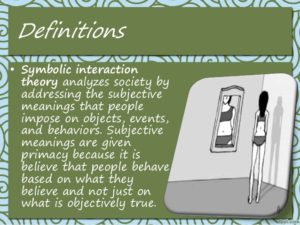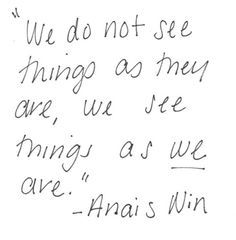Lesson Objectives:
- identify how one-on-one relations build society
- review theoretical approaches to social relationships
- define and recognize social constructs
- evaluate how invented ideas create real effects in society
 Societies and institutions are comprised of one-on-one interactions between individuals which are known as social relations. The ways that people engage in social interaction is largely informed by the cultural norms and values that provide the framework for human behavior. According to Max Weber, an “Action is ‘social’ if the acting individual takes into account the behavior of others and is thereby oriented in its course” (Secher 1962). What this means is that people act according to specific social contexts and how they expect others to react to their action. If there is a negative response, the action is modified. This is important because as people modify their (inter)actions, they also modify the institutions that inform culture. This is why culture and institutions are dynamic and constantly changing to new circumstances.
Societies and institutions are comprised of one-on-one interactions between individuals which are known as social relations. The ways that people engage in social interaction is largely informed by the cultural norms and values that provide the framework for human behavior. According to Max Weber, an “Action is ‘social’ if the acting individual takes into account the behavior of others and is thereby oriented in its course” (Secher 1962). What this means is that people act according to specific social contexts and how they expect others to react to their action. If there is a negative response, the action is modified. This is important because as people modify their (inter)actions, they also modify the institutions that inform culture. This is why culture and institutions are dynamic and constantly changing to new circumstances.
 Social Action Theory requires the anthropologist to look beyond institutions (structuralism) and interrogate the dyadic, one-to-one, relations within groups of individuals in order to understand the forces that shape culture. The task of the anthropologist is interpret the meanings of social actions within the context of that action. According to Weber,
Social Action Theory requires the anthropologist to look beyond institutions (structuralism) and interrogate the dyadic, one-to-one, relations within groups of individuals in order to understand the forces that shape culture. The task of the anthropologist is interpret the meanings of social actions within the context of that action. According to Weber,
(Social Science is) ‘..the science whose object is to interpret the meaning of social action and thereby give a causal explanation of the way in which the action proceeds and the effects which it produces. By ‘action’ in this definition is meant the human behavior when and to the extent that the agent or agents see it as subjectively meaningful … the meaning to which we refer may be either (a) the meaning actually intended either by an individual agent on a particular historical occasion or by a number of agents on an approximate average in a given set of cases, or (b) the meaning attributed to the agent or agents, as types, in a pure type constructed in the abstract. In neither case is the ‘meaning’ to be thought of as somehow objectively ‘correct’ or ‘true’ by some metaphysical criterion. This is the difference between the empirical sciences of action, such as sociology and history, and any kind of priori discipline, such as jurisprudence, logic, ethics, or aesthetics whose aim is to extract from their subject-matter ‘correct’ or ‘valid’ meaning.
— Max Weber The Nature of Social Action 1922
Weber’s theory of social action provided the foundation for Geertz’s interpretative theoretical framework previously discussed in Module one. Another important contribution of Weber’s approach is that it presents the individual as an active agent rather than a passive reactionary. The notion of Agency is a key aspect of Pierre Bourdieu’s Practice Theory which we will explore in greater detail in the fifth module.
Symbolic Interaction
T here are a wide variety of theoretical approaches aiming to identify the different motives that inform individual action (rational action, affective/emotional action, etc. that we will not discuss here. However, it is important to note that human action differs from non-human primate action because people rely on symbols and meanings to define and interpret social relations (Blumer 1969). What this means is that people organize and make sense of the world, including themselves and others, by assigning symbolic meanings to individuals and their position in society. Assigned meanings shape cultural expectations, norms and values for social behavior; shared meanings provided the basis for group formation, and different meanings give rise to cultural diversity. This is a central aspect in the approach to the concepts introduced in this module; sex, gender, family, and race. We will interrogate the ways that these concepts are socially created, or socially constructed, by groups and individuals that assign meanings to sex, gender, family and race in different ways.
here are a wide variety of theoretical approaches aiming to identify the different motives that inform individual action (rational action, affective/emotional action, etc. that we will not discuss here. However, it is important to note that human action differs from non-human primate action because people rely on symbols and meanings to define and interpret social relations (Blumer 1969). What this means is that people organize and make sense of the world, including themselves and others, by assigning symbolic meanings to individuals and their position in society. Assigned meanings shape cultural expectations, norms and values for social behavior; shared meanings provided the basis for group formation, and different meanings give rise to cultural diversity. This is a central aspect in the approach to the concepts introduced in this module; sex, gender, family, and race. We will interrogate the ways that these concepts are socially created, or socially constructed, by groups and individuals that assign meanings to sex, gender, family and race in different ways.
Social Constructionist Theory
 Social constructionist theory is informed by post-Enlightenment ideas that emerged from the euro-centric intellectual movement during the 15th -18th centuries when science began to contest religious and hierarchical interpretations of reality that were based on unquestionable assumptions and Truths regarding the ‘natural order of things’ and the way ‘God intended’. Revolutionary philosophers, such as Jean-Jacques Rousseau and Mary Wollstonecraft began to challenge social hierarchies that were based on essentialist ideas that were rooted in the platonic philosophy that any specific entity has a set of properties which any entity of that kind must possess. In other words, an essentialism is a generalization stating that certain properties possessed by a group are universal and independent of context. From this perspective, a tiger is expected to be and act the same because it possesses the ‘essence’ of a tiger, regardless of whether it lives in a zoo or in the wild. This same approach was also applied to different groups of people, and informed the creation of social and racial taxonomies and the justification of inequality.
Social constructionist theory is informed by post-Enlightenment ideas that emerged from the euro-centric intellectual movement during the 15th -18th centuries when science began to contest religious and hierarchical interpretations of reality that were based on unquestionable assumptions and Truths regarding the ‘natural order of things’ and the way ‘God intended’. Revolutionary philosophers, such as Jean-Jacques Rousseau and Mary Wollstonecraft began to challenge social hierarchies that were based on essentialist ideas that were rooted in the platonic philosophy that any specific entity has a set of properties which any entity of that kind must possess. In other words, an essentialism is a generalization stating that certain properties possessed by a group are universal and independent of context. From this perspective, a tiger is expected to be and act the same because it possesses the ‘essence’ of a tiger, regardless of whether it lives in a zoo or in the wild. This same approach was also applied to different groups of people, and informed the creation of social and racial taxonomies and the justification of inequality.
In his essay, Discourse on the Origin and Basis of Inequality Among Men (1755), Rousseau identified two forms of inequality: natural and social. According to Rousseau, people are born with natural inequalities associated with physical strength. Yet, the second form of inequality, social inequality, is based on power and wealth differentials in society. Rousseau’s work paved the path for a series of inquiries into the many different ways that social hierarchies are created and maintained through inequities in power and the differential distribution of resources in society.
Despite new perspectives on the origins of inequality, many essentialisms continue to operate today and inform popular stereotypes about different groupings of people. What are some common essentialisms in contemporary American society?
Poor people are …. ‘Black’ men are … ‘White’ people can’t … Muslims are … Gay men are … Women are …… and the list goes on.
In many cases, essentialisms serve to rationalize social marginalization and inequality because they tie a person or group’s social positioning to a trait or characteristic that is presumed to be universal to that particular person or group. Y et, social constructionist theory posits that particular phenomena, ideas and concepts develop, not out of a natural order, but within specific social contexts. What this means is that patterns within a population do not emerge from within the group, but from the external conditions or contexts experienced by members of the group. For example, a recent poll found that more than a quarter of Americans believe that Poor people are lazy. Essentialisms that associate poverty with laziness help to rationalize the growing conditions of poverty experienced by an increasing population of people in the United States. Yet, social constructionist theory interrogates the social contexts that create the conditions of poverty within a society, such as economic exclusion, racism, or restricted access to resources for certain members of society. Similarly, Loic Wacquant challenges the popular essentialism that Black men are criminals in his article, From Slavery to Mass Incarceration, by unveiling the socio-historical context of race, economics and law in the United States.
et, social constructionist theory posits that particular phenomena, ideas and concepts develop, not out of a natural order, but within specific social contexts. What this means is that patterns within a population do not emerge from within the group, but from the external conditions or contexts experienced by members of the group. For example, a recent poll found that more than a quarter of Americans believe that Poor people are lazy. Essentialisms that associate poverty with laziness help to rationalize the growing conditions of poverty experienced by an increasing population of people in the United States. Yet, social constructionist theory interrogates the social contexts that create the conditions of poverty within a society, such as economic exclusion, racism, or restricted access to resources for certain members of society. Similarly, Loic Wacquant challenges the popular essentialism that Black men are criminals in his article, From Slavery to Mass Incarceration, by unveiling the socio-historical context of race, economics and law in the United States.
From a social constructionist perspective, popular conceptions are social constructs, invented ideas that originate in a particular social system yet appear natural to those who accept it. They appear natural because, like culture, the ideas are learned and shared. Social constructs are embedded in culture and language; they inform the ways that people organize and represent reality (Berger and Luckman 1966). Because they are learned and shared, social constructs are also dynamic because people reproduce them according to their own interpretations and changing circumstances.
This module will investigate the ways that sex, gender, family, household and race are socially constructed in societies differently through space and time. It will also address that although the concepts are invented within a particular social system, they incur real experiences for people living in a particular society.
Readings: Berger and Luckmann. The Social Construction of Reality, ‘Introduction”
Your Score:
Your Ranking:
Discussion: Think of a social construct, an invented idea that is taken for granted as ‘natural’ – how does it operate in society today? Does it help to reinforce or maintain social inequality? In what ways do people learn and share this construct? Can you provide an example of how this construct is represented in media? Use terms and concepts from this lesson and respond to other student posts.
When you complete the discussion, move on to the Sex & Gender lesson.
